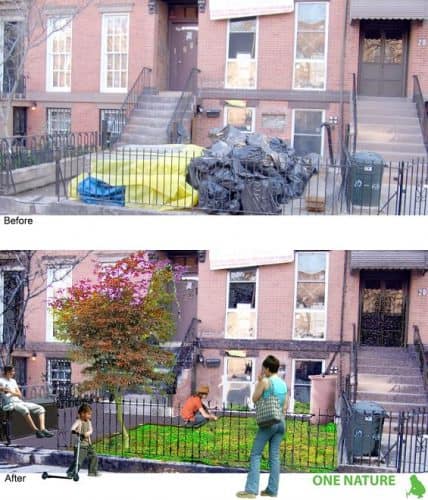For the front yard of the Brooklyn Green Show House we are working with Bryan Quinn from One Nature Design.
Building an ecological garden in Brooklyn is pretty easy. You have lots of rain and good earth. Even lawns can survive here without water. But being a forever innovative company we are tapping into Bryan’s creative depths to see how green we can push ourselves.
The idea is to create a sponge lawn in front of your model home that reuses a very high amount of existing on-site materials. The current front yard is all concrete, the reasoning being that you can’t get much lower maintenance than a garden of concrete. Put a Dwarf or two and you’re set!
Of course our idea is to reduce the amount of water that flows into the sewers or the Gowanus Canal when the stinky sewers overflow.
The details of our preliminary draft are like this:
* For the walk way we leave most of the concrete down and dry lay blue stone over it on stone dust.
* We harvest all the water we can from the front downspout into a seasonal rain barrel. This water runs in irrigation tubes buried under the “sponge lawn” of sedum (like on green roofs) and other groundcover plants. We’ll put the cobble stones in the lawn, too, to help the water move, but they will be quickly covered by the plants as they mature.
* We remove about 16SF of concrete for disposal and for the dry bed. After removing, we excavate another 4-5′ down and use construction debris or broken concrete to build a dry well so we get some drainage. Then we plant a tree over top of the drywell so its roots can get deep below the frost line.
* The edge between the “sponge lawn” is made form long lengths of wood (or whatever other long lengths of material we can find from the construction site) or more of the stones we salvaged from digging out the basement. We embed green (the color) solar LED lights (4″ x 6″) into the edge so at night the landscape has a green glow to it (yea we’re a little weird).
* The diagram below shows a metal box for the trash can and we’re going to see if we can half submerge the trash box under ground and have the top half of the box be a bench. You lift the bench and voila the stinky garbage (we would create a nice tight seal on the lid so your sitting is not disturbed by smell).
The ‘big’ costs here will be:
* labor
* the tree
* the rain barrel and tubing
* sedum and other groundcover plants
Really should not amount to much $, however. It would fit well into the neighborhood character too–there is no reason ecologically minded design has to class with the neighbors (unless you want it to because the neighbors are so horribly non-ecological, but our neighbors are cool).

